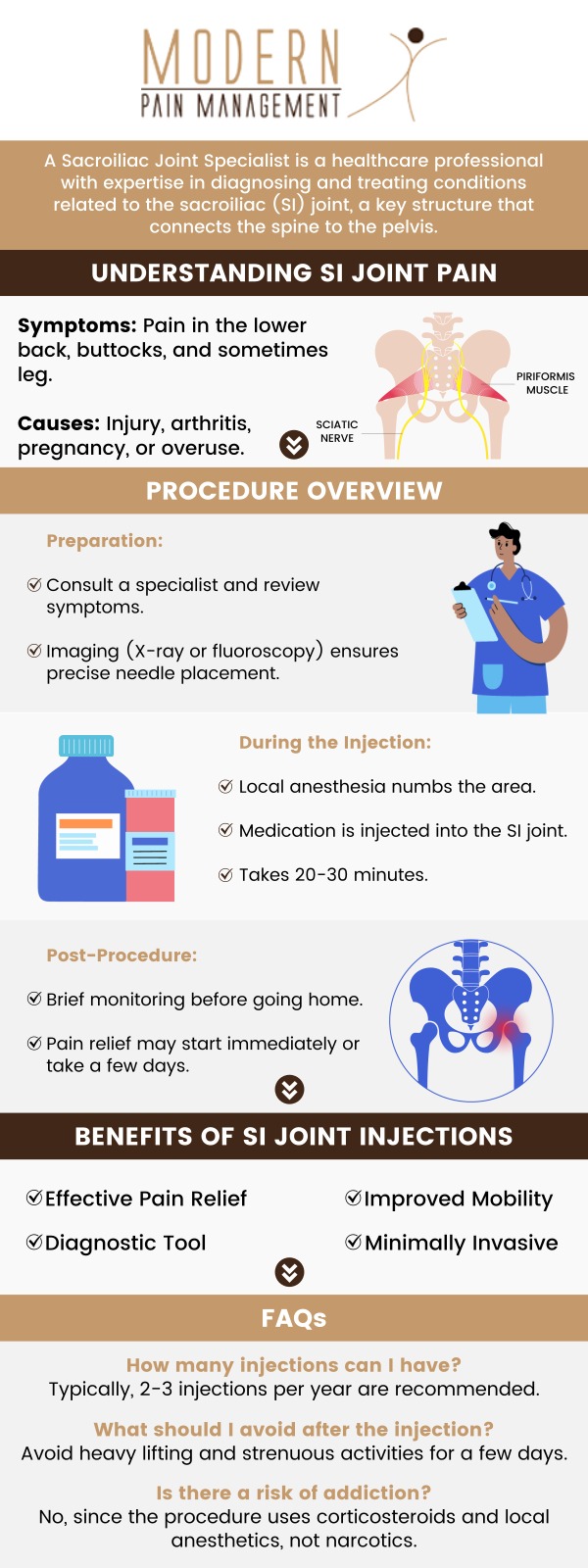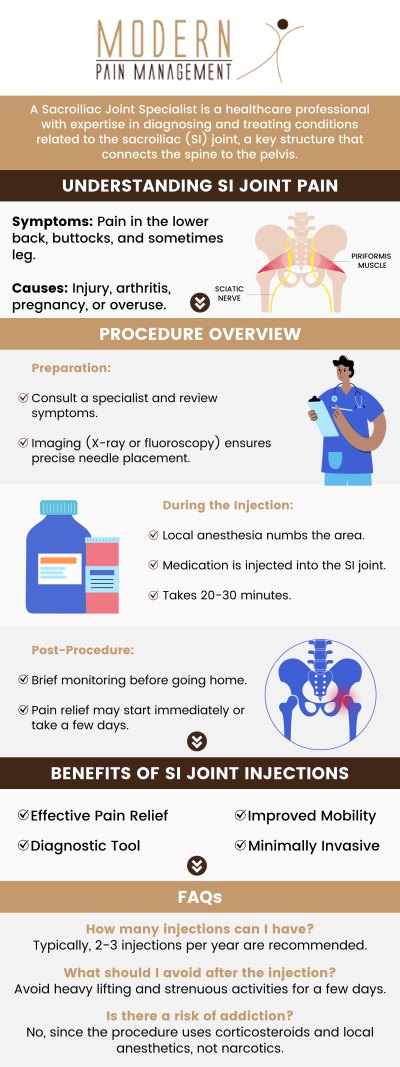Symptoms of SI Joint Dysfunction Q&A
Incorrect movement of the joints at the base of the spine that connect the sacrum to the pelvis causes sacroiliac joint dysfunction, resulting in lower back, and leg pain, as well as joint inflammation. Dr. George Atallah, DO, and his team at Modern Pain Management will use innovative strategies for managing the discomfort caused by SI joint dysfunction. For more information, please contact us or book an appointment online. We have convenient locations to serve you in Houston, TX, and Sugar Land, TX.




Table of Contents:
How do you know if you have SI joint dysfunction?
What is the root cause of SI joint dysfunction?
What are the red flags for SI joint dysfunction?
What does an irritated SI joint feel like?
SI joint dysfunction, also known as sacroiliac joint pain, is a common condition that affects millions of people worldwide. It occurs when the joints between the sacrum and the ilium bones become inflamed or irritated, leading to discomfort and pain in the lower back, buttocks, hips, and legs.
Modern Pain Management offers innovative solutions for relieving the discomfort associated with SI joint dysfunction. Utilizing a multidisciplinary approach, we combine pharmacological and non-pharmacological therapies that aim to alleviate pain and improve quality of life. For instance, physical therapy exercises can strengthen the muscles around the SI joint, reducing instability and enhancing mobility. Pain medication and anti-inflammatories can help control the inflammation and pain. In more severe cases, minimally invasive procedures, such as SI joint injections or radiofrequency ablation, may be employed. These cutting-edge treatments aim to directly target the source of the pain, offering more effective and long-lasting relief compared to traditional methods. Our goal at Modern Pain Management is not just to treat the symptoms, but to address the underlying causes of SI joint dysfunction, offering patients a comprehensive solution for their condition.
The symptoms of SI joint dysfunction can vary from person to person but commonly include:
Lower back pain: The most common symptom of SI joint dysfunction is pain in the lower back, typically on one side. This pain may feel sharp or dull and can be aggravated by certain activities such as walking or standing for prolonged periods.
Buttock pain: Many people with SI joint dysfunction also experience pain in their buttocks, which may radiate down the back of their legs. This pain is often described as a deep ache or burning sensation.
Hip pain: Due to the proximity of the SI joint to the hip, dysfunction in this area can also cause pain in the hip. This pain may be felt on one or both sides and can make it difficult to move or put weight on the affected side.
Stiffness and reduced mobility: SI joint dysfunction can also lead to stiffness in the lower back, hips, and legs. This can make it challenging to perform daily activities such as bending, walking, or sitting for extended periods.
Numbness or tingling: In some cases, SI joint pain can cause numbness or tingling sensations in the legs, which can be mistaken for sciatica. This is due to pressure on the nerves that run through the affected area.
If left untreated, SI joint dysfunction can significantly impact an individual’s quality of life, making it difficult to perform daily tasks and participate in physical activities. However, with proper treatment, most people can find relief from their symptoms and resume their normal activities.
The exact cause of SI joint dysfunction is still not fully understood, but it is believed to be a result of several factors. These include:
Trauma or injury: A sudden impact or repetitive strain on the SI joint can lead to inflammation and pain.
Pregnancy and childbirth: The hormonal changes during pregnancy can cause ligaments around the SI joint to loosen, leading to instability and pain. The act of giving birth can also put stress on the joint, exacerbating any existing issues.
Arthritis: Osteoarthritis or inflammatory arthritis can affect the SI joint, leading to degeneration and pain.
Poor posture or biomechanics: Misalignments in the spine or hips can put extra pressure on the SI joint, causing dysfunction over time.
While the symptoms of SI joint dysfunction may overlap with other conditions, there are some red flags to look out for that may indicate a more serious issue. These include:
Severe pain: If the pain is intense and unrelenting, it may indicate a more severe problem such as a fracture or infection.
Fever and chills: These symptoms can signal an infection in the joint, which requires immediate medical attention.
Loss of bladder or bowel control: This may indicate nerve damage and requires urgent evaluation.
If you experience any of these symptoms, it is crucial to seek medical attention immediately. Ignoring red flags can lead to further complications and delay proper treatment.
An irritated SI joint can feel like a sharp or dull pain in the lower back, buttocks, hips, and legs. This pain may worsen with certain activities such as walking or standing for prolonged periods. It may also cause stiffness and reduced mobility in the affected area. In some cases, an irritated SI joint may also cause numbness or tingling sensations in the legs. As symptoms can vary from person to person, it is essential to consult a healthcare professional for an accurate diagnosis and appropriate treatment plan.
If you’re suffering from symptoms reminiscent of SI joint dysfunction and are in search of pain management solutions, don’t hesitate to reach out to our team of experts. We’re committed to providing comprehensive care and innovative treatments that target not just symptoms but the root cause of your discomfort. Your journey towards pain relief and an improved quality of life could start today. Contact us or book an appointment online to take the first step in managing and overcoming SI joint dysfunction. We serve patients from Houston TX, Sugar Land TX, Pearland TX, Jersey Village TX, Missouri City TX, Stafford TX, and Richmond TX.
ADDITIONAL SERVICES YOU MAY NEED




